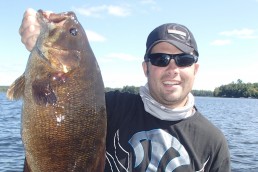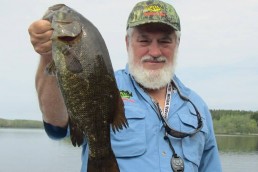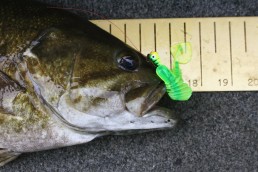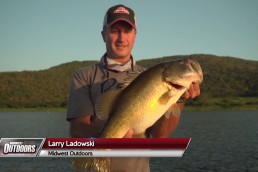Mysteries of the Deep: Cisco-schooling Smallmouths Part 2
SHARE THIS POST
Exploring the mysteries of the deep, and examining the behavior of open water fish
Cisco swimmers
These last few seasons, Cody Hahner, touring FLW angler and I have messaged often about swimbait tactics and open water fishing strategies. We’ve learned that, some days, fish go wild for a 3-hook Alabama rig, as Hahner employs. While, other days, they prefer a single paddletail with a steady and erratic retrieve. I often bomb cast and slow roll through the water column.
The swimbait is the most powerful big smallmouth bait Hahner has in his boat.
He often fishes the Alabama rig from early to mid pre-spawn, midsummer, and late fall. “Fish group up in deeper water during these periods and often suspend just off the bottom,” he says. The rig gives anglers the opportunity to show bass a school of bait rather than a single offering.
The 3-hook A-rig dismantles smallmouth for Hahner. “The late fall is, by far, my favorite time of the year to fish for giant smallmouths,” he says.
The cisco spawn is a prime, heavy feeding period of the year for all gamefish species. It takes place from the last week of October through early November, when water temperatures are in the mid-to-low ‘40s. At this point, smallmouths are congregating in their largest schools of the year and can be caught very easily.
Hit ‘em where they live
“This time of the year, I’m looking for rock structures adjacent to the basin where cisco have been living for most of the year. More specifically, I am looking for bars that top out around the 20-foot mark and are right in line with gravel banks which cisco use to spawn on. Smallmouths are able to anticipate prey movements and are looking to put on the feedbag for the upcoming winter. By far, this is the best time of the year to utilize swimbaits and, more specifically, the A-Rig. The A-Rig is the perfect mimic of a school of ciscoes following structure to move into their spawning grounds,” he concludes.
In Hahner’s opinion, the rig works best with a chop or overcast conditions because of its gaudy wires. These factors help hide the rig and create a better illusion for the fish.
“The A-Rig creates the perfect illusion of a small pod of bait that has broken off of the larger school. It has a greater draw power than a single bait which makes it an excellent choice when fishing for suspended deep-water fish. I prefer to fish this bait on a very slow, steady retrieve with sudden, fast turns of the reel handle to cause the bait to flare and pulse. Smallmouths have a tendency to follow this bait until they see a sign of weakness. An abrupt burst of speed during a slow-crawling retrieve often is the trigger needed to create frenzy in a school of following smallmouths,” he elaborates.
Rigging for results
Hahner rigs the bait with five natural-colored swimbaits that are 3-to 4-inches long on three ¼-ounce swimbait heads and two hookless dummy swimbaits to stay within Wisconsin Law.
His swimbait selection varies, letting the smallmouths dictate his choice. “If the fish are active, I like a 3.8-inch or 4.8-inch Keitech Fat or a Big Bite Baits 3.5-inch suicide shad,” he says.
Both baits have a hard-kicking action and work best for him in warmer water or when weather conditions like wind, overcast, or an incoming front allow it.
“When the water is cold or fish are in a neutral or negative mood, I prefer a Damiki anchovy shad, Keitech 2.8-inch Fat, or a Keitech 4-inch Easy Shiner. All these baits have a more subtle action and work best for me when dealing with cold water or postfrontal conditions,” he says.
Hahner’s setup is fished with a 7-foot, 11-inch St. Croix Legend Tournament (heavy, moderate fast action) flipping rod, paired with a slower, powerful 6.6 gear-ratio reel. The long, heavy rod enables him to cast the bulky rig, and its moderate-fast action helps keep fish pinned following hook set. The reel retrieves easier and prevents him from overfishing the rig. He prefers a heavy line such as 60-pound Sunline fx2 braid, if water color allows, to accommodate for the size of the rig. If fish are line shy of the braid, he will use 22-pound Sunline Shooter Fluorocarbon.
Single swimmers when the going gets tough
The Alabama rig is a powerful bait under certain circumstances, but it does have its weaknesses, admits Hahner.
“Negative fish, slick conditions, and fish closer to structure call for single swimmers. Single swimmers offer a much less aggressive offering to the bass. Oftentimes, I’ll switch to a single swimbait or an underspin when I need a bait that I can fish closer to bottom with or when fish are bumping but not eating the A-Rig,” he concludes.
While it’s less elaborate and technical than Hahner’s Alabama rig, my single-swimmer option has become a go-to presentation that excels from mid-July through post-turnover in late October.
Casting a single swimmer is easy and engaging fishing that plays well on our clear water smallmouth fisheries of Wisconsin.
Take a 3.8-inch paddletail and rig it on a swimming-style jighead. Bomb cast, count the bait down to the suggested depth of the cisco school and let the wagging tail and wobble of the head do the work for you. A slower, steady retrieve is best, but I will mix it up with rips and pauses so that the bait slow-rolls back to the bottom and the illusion of a minnow in distress triggers a strike. Maintain the depth ciscoes and smallmouths are at.
Are you enjoying this post?
You can be among the first to get the latest info on where to go, what to use and how to use it!
I employ two swimmer systems. The first, and my preferred, is fished with a Freedom Tackle Corp. Hydra ½-ounce, swinging-head jig in white. It promotes power, vibration, and a wide wobble from head to tail. The second is a 3/8-ounce and ½-ounce Trokar Boxing Glove jig that serves well as a finesse option.
The interchangeable lure characteristics and swinging arm properties of the Freedom Hydra enable maximum movement of the paddletail and presentation, in addition to preventing big fish from eventually throwing hooks. The Hydra is a perfect match with a 3.8-inch Kalin’s Sizmic Shad in white crystal.
With the Hydra weedless-rigged with a favorite 3/0 Trokar Magworm hook, my swimbait has a wider side-to-side kick and more powerful thump to trigger strikes. When swum with a slow to medium retrieve, the jighead itself shivers and quivers with heavy vibration, catalyzing the movement for this entire big-fish-catching package. Many fish caught with this setup were observed charging the bait from a great distance away; likely an indicator that they will explosively charge at cisco schools in similar fashion.
If smallmouths aren’t charging hard at the swimmer, tone down the presentation action by fishing the Trokar Boxing Glove Jig with 3.8-inch Rage Swimmer in Ayu, Pearl Flash, and Pro Blue Red Pearl. The exposed hook will restrict the swimbait’s motion and tail action, but will pin nearly every fish that strikes or nudges the bait.
Eurozone cisco simulators
Because ciscoes come in larger sizes, it’s advisable to increase the beefiness of your presentation some days. A suggested swimbait option for this is Sweden-sourced, Svartzonker Tackle. While their European swimbaits are designed for muskie and northern pike, they offer a downsized, lively, 5-inch paddletail with a huge thump—the McRubber Bass. It can be fished with both my jighead and swinging head methods.
For this open water casting strategy, I’m obviously looking for pods of ciscoes on side imaging, but also looking for mid-depth and shallow humps and rock structure that are immediately near deep, open water and main lake basins. Big smallmouths often use the deep edges and bases of those humps as ambush points to gang up on schooling ciscoes passing by.
Smallmouths will form wolfpacks for feeding. They will group with other specimens of similar size to ambush prey since this makes them more effective hunters. Despite this trend, Hahner and I have observed different feeding behaviors. The queen bass we’ve caught from these cisco lakes are usually rogue, solitary fish. They want nothing to do with the smaller 20 inchers for aid in ambushing and corralling ciscoes. Rather, it seems these heavyweight 6 and 7 pounders want to own an entire submerged hump and capture all the food by themselves.
For slinging with the ½-ounce heads, I work with a variety of 7-foot, 2-inch to 7-foot 6-inch Vexan Bass and Quantum PT medium-heavy fast-action casting rods. I pair them with Quantum PT casting reels with 7.0 gear ratios. This gear ratio is suitable for all-purpose casting and varied retrieve speeds.
Drop me a line
It might be sacrilege to not use braid, but I like some stretch to my hook sets, the shock absorption from casting, and I almost never have problems with losing fish from afar. I fish with a 15-pound, low-stretch copolymer manufactured by Cortland Line and tie directly to the jig. I’m not a fan of braid for most bass-casting applications, anyway, and have zero confidence in any fluorocarbon leader material to attach to main line, unless I am jigging. Nearly all fishing partners and guests of mine have experienced breakoffs on hooksets and in the midst of long-distance casting. With the copolymer line, I simply retie after every big bite and check for line kinks periodically.
Size up your ciscoes
Hahner and I agree that the size of swimbait is the most important consideration to this style of fishing. Choose your sizes based on the length of the forage. Our go-to sizes are the standard 3.8-inch lengths for most cisco-fishing situations. Young-of-the-year ciscoes are about this length by August and September.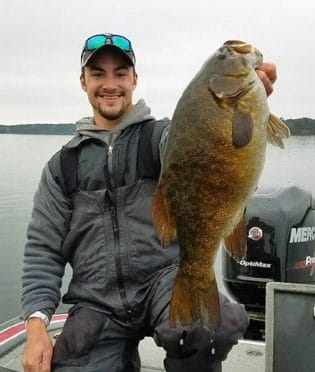
Whether ciscoes school by size is unknown, but their behavior and presence is far more elusive than most gamefish species. Beyond electronics, anglers will seldom see ciscoes, dead or alive, in the wild unless a summer die-off or their annual late fall spawning runs send a few expired fish to the surface.
In Wisconsin’s inland lakes, a 15 incher is a big one, but not possible for smallmouths to consume. This is why Hahner and I will downsize our swimbaits to realistic sizes that smallmouths could handle. In the wild, smallmouths probably target the juvenile and midsize members of the cisco population most often. For size comparison, 4-inch ciscoes are typically 1-year-olds, while 7-inch ciscoes are 2-year-olds.
No more embellishing your fish stories
Mysteries of the deep are revealed in smallmouths’ fishing sense. Big fish or bust! This bold and innovative open water fishing strategy has already resulted in a number of personal bests. Bigger records could break too, someday.
Few inland Wisconsin waters are capable of rearing 6 pounders. Fewer are able to rear a fish surpassing 7 or 8 pounds. Are the northern inland lakes, which have ciscoes and low-density trophy smallmouth populations, capable of ever breaking the current Wisconsin state record of 9-pounds, 1-ounce?
That’s a story and debate for another time. As adept anglers know, cisco lakes and their low-density trophy smallmouth fisheries are the ingredients to growing monstrous bass. These factors increase the odds for a potential record breaker.
Bass anglers miss fish, failing to locate and reach them with every cast. Meanwhile, DNR crews miss fish during surveys too, as fish sometimes evade their nets and boom-shockers. Much like the oceans, the deep basins and open waters of our lakes are an undiscovered, untapped pelagic world of migratory prey fish and predators. A lot remains to be further learned from exploring the mysteries of the deep, and examining the behavior and elusiveness of open water fish.
Keep casting for unicorns. Giant smallmouths of your wildest dreams do exist.
Andrew Ragas splits time between the Chicago area and Wisconsin’s Northwoods. Based in Minocqua, Wisconsin, he specializes in bass fishing and offers guided trips. Contact him through his website, northwoodsbass.com.
MWO
SHARE THIS POST
Did you enjoy this post?
You can be among the first to get the latest info on where to go, what to use and how to use it!
Andrew Ragas
Andrew Ragas splits time between Chicago and Wisconsin’s Northwoods. Based in Minocqua, Wis., he specializes in trophy bass fishing and offers guided trips from May through October. While big bass are his passion, he dabbles in multispecies, as well. He may be visited online at northwoodsbass.com
